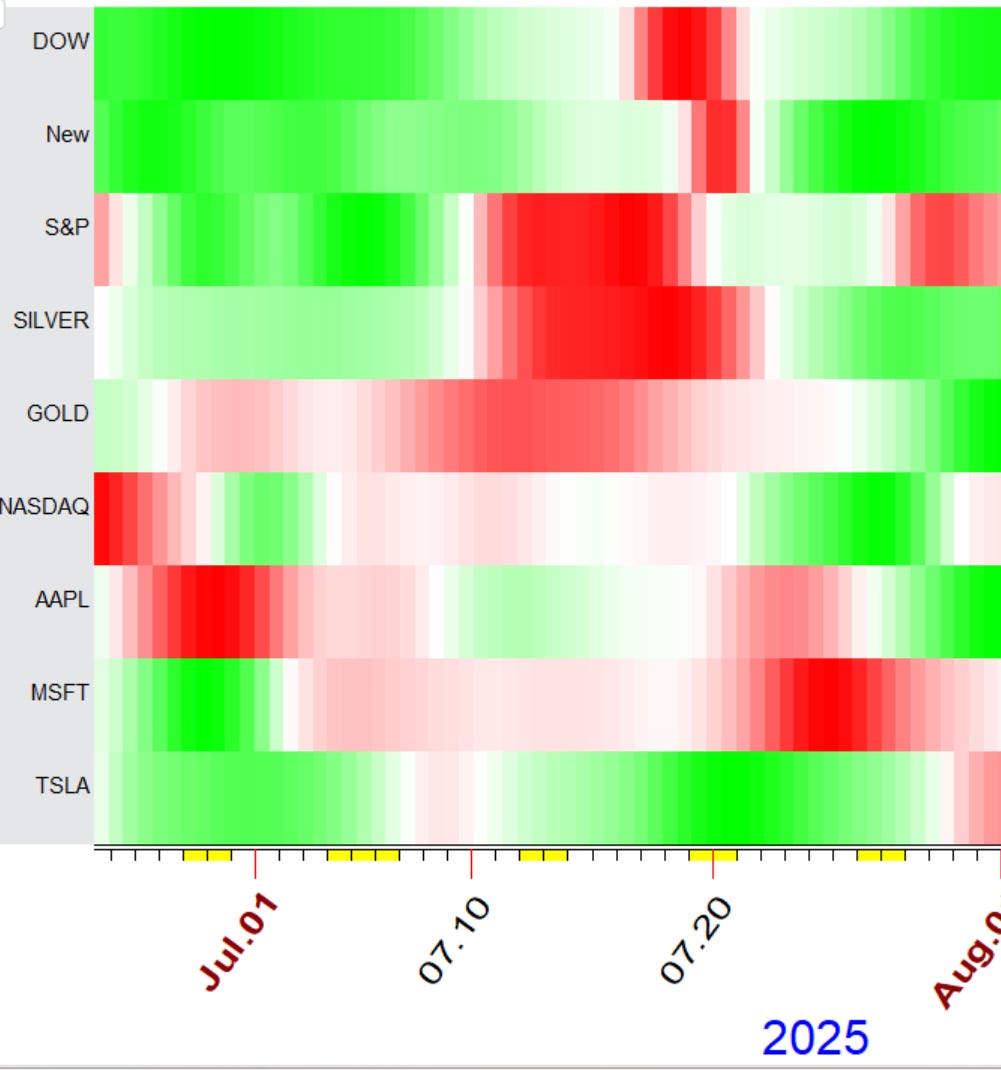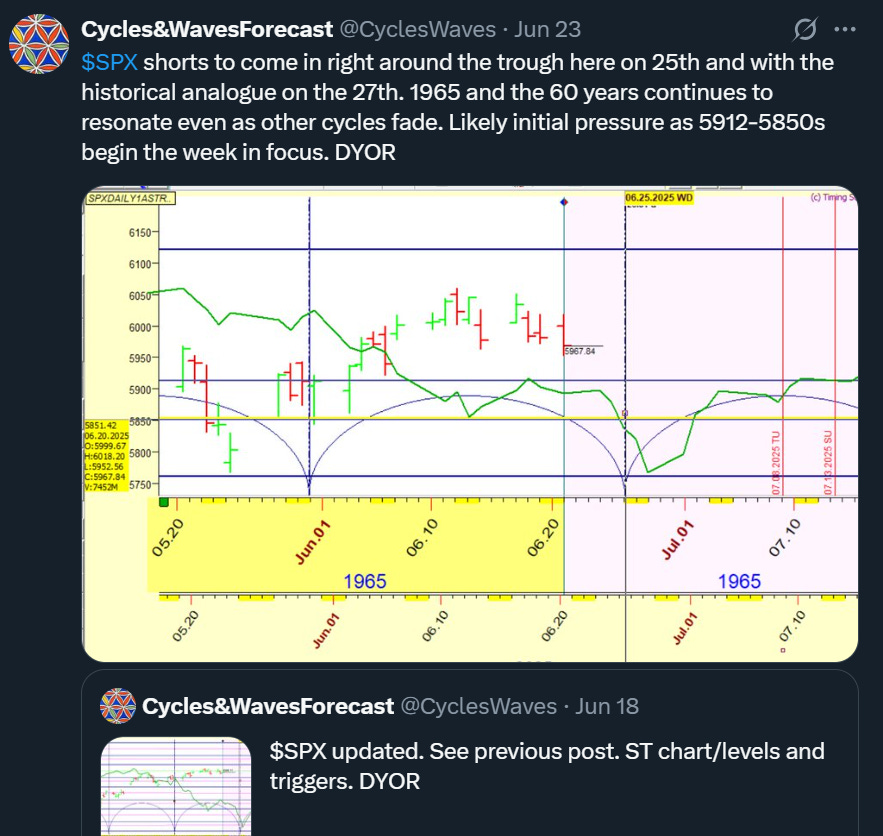I often return to Martin Armstrong and have done so today to show a particular technique I use. In the Economic Confidence Model (ECM) Armstrong proposes an 8.6-year cycle in economic and financial markets which he links to the mathematical constant pi (π ≈ 3.141). The 8.6-year cycle itself is derived from historical financial panics between 1683 and 1907 where 26 panics over 224 years give an average interval of 8.6 years. (224 / 26 ≈ 8.615). Armstrong then rounded this down and calculated that 8.6 years equals 3,141 days which is π × 1,000, suggesting a connection between this cycle and pi as a fundamental ratio governing natural and economic rhythms. He argued this reflected the "Geometry of Time."
The ECM model itself can be seen pictorially below and is broken down into cycles and modelled well ahead of time by his computer.
Armstrong further divides the 8.6 year business cycle into four 2.15 year intervals and this is where we see more explicitly the Venus connection and the magical vibration of 7. The Venus Cycle is calculated as 224.7 days. Each 2.15 year cycle will therefore trace 3.5 orbits of Venus. Seven orbits of Venus equal 4.3 years or two 2.15 year cycles (224.7 * 7/365.25.
The Armstrong cycle above is also coincidently of a similar length to the Venus Pentagram Cycle, known as the Rose of Venus, or Pentagram of Venus which refers to the geometric pattern traced by Venus in the sky when observed from Earth over an approximately 8-year period. Venus traces a five-pointed star (pentagram) or a rose-like pattern in the sky, with each point or "petal" corresponding to one of five inferior conjunctions (when Venus passes between Earth and the Sun). The 144-degree move refers to the angular shift between successive inferior conjunctions in this cycle.
I do not intend to dwell on this, as you may research further if you choose, but would note I follow this pattern very closely when looking for turning points to occur. Together there appears a cosmic and geometric tune playing out and resonating throughout the universe. As above so below.
July Rise Before The Fall
So why do I mention this now? Well, one technique I use is to scale to pi or a ratio of pi. This technique was one I first saw used by Diego Ratto in his book, “Wall Street Watchmen” and I shall leave you to research further if interested. The idea is that just as in geometry we can square the circle using pi then also in markets we can ‘square both time and space in time cycle analysis’ (p16 2010) This technique is a useful addition to using planetary lines and/or planetary fans as well as the more popular but often incorrectly scaled Gann fans.
Returning to Armstrong below, Grok has calculated the turning points from the historical anchor above. Now it is important to note that the points may be some weeks off and are just a guide but it is clear we are expecting a low to be made in June. This also aligns with other cycles I have been following. To date we have not had any meaningful correction in the main indices and we are now running out of time as I expect a further rise to occur towards the last week of June until between the 7th-13th but possibly as far as 20th of July when we might expect another correction to occur before a further brief rise into August and a key turning date.
Below we can see the prediction models for some instruments below in the coming weeks. I have also added some charts.
$SPX
$TSLA
$AAPL
BONUS CHARTS $COIN
$XLY
Astrological Signature In July
Uranus moves into Gemini 7th July, 2025
Event Description: Uranus, the planet of innovation, disruption, and sudden change, moves from Taurus into Gemini on July 7, 2025, for a brief period (until November 7, 2025, before retrograding back to Taurus). This marks the start of a significant shift in communication, technology, and intellectual pursuits, as Gemini governs these areas. Uranus last transited Gemini from 1941–1949, a period marked by communication breakthroughs like the rise of television.
Financial Astrology Impact: Uranus’s unpredictable nature could lead to sudden market swings, especially in tech or communication-related sectors.
Saturn Retrograde in Aries Begins July 13, 2025
Event Description: Saturn, the planet of discipline, structure, and karma, begins its retrograde in Aries on July 13, lasting until November 28, 2025.
Financial astrology, Saturn governs long-term investments, financial discipline, savings, and structures like institutions, corporations, and markets. Its retrograde in Aries is interesting as Aries is a risk taker and more impulsive. This creates a time of reflection but also a potential for corrections in tech or crypto related industries as regulation and innovation face off. The result of this meeting will help determine the strength of the market going forward particularly due to the weighting of tech in the market.
Mercury At Aphelion 14th July and then Retrograde in Leo (July 17–August 11, 2025)
Event Description: Mercury, the planet of communication, commerce, and contracts, goes retrograde in Leo.
Financial markets could experience short-term volatility, both up and down, due to miscommunications or regulatory shifts, particularly in industries tied to entertainment, luxury, or creative sectors (e.g., media or fashion).
Mars Conjunct the South Node (Ketu) in Virgo (July 20, 2025) see previous note Vedic-Sidereal
Event Description: Mars, the planet of action and drive, aligns with the South Node in Virgo, a point associated with past patterns and release. See previous post.
Conclusion
We could see an explosive move up until around the mid of July before another period of significant risk until 28th July. The date between 7th and 13th aligns with more tariff news so there is obvious risk ahead. I still expect a main turning point to occur in August which may lead to a significant fall.
Turning Points: July 7 UP, 13, 17, 20/22 DOWN.
6/24 TO BE UPDATED
Disclaimer: Do your own research. The content provided is intended for educational and informational purposes only. It should not be construed as any form of advice. I am not a financial advisor and do not accept any loss or liability for any damage or loss you may incur. Take appropriate independent financial advice suitable for your own circumstances before making any investment decision. Be a responsible person and take responsibility for your life and your decisions.














